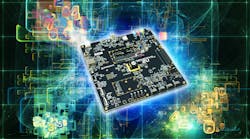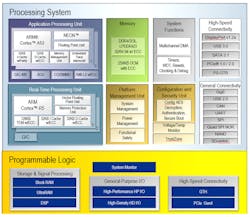Download this article in PDF format.
Most engineers start their design with some development hardware and software. Design usually begins with a development system provided by microprocessor (MPU) or FPGA manufacturers. This works fine with a single processor, but when the design calls for multiple MPUs and/or FPGAs or other chips, the development prototype gets complicated real fast.
Development platforms are perpetually becoming bigger and more complex due to larger, more complex applications. Defense, aerospace, machine vision, cloud computing, and especially artificial intelligence (AI) are examples of applications that require considerable computing capability.
Digilent, an engineering products company with a history of designing development boards, advanced educational hardware, virtual instruments, and related products, has crafted new development boards featuring FPGAs, MPUs, and all of the support devices you need to create your final product. There’s no longer any need to cobble together multiple boards with their different interfaces and different software needs.
One such board is the Digilent Genesys ZU Zynq UltraScale+3EG MPSoC. It’s loaded with multiple systems-on-chip (SoCs), MPUs, I/O ports, and many other fully integrated parts. The platform could be the solution for those looking to minimize design time and cost.
Sponsored Resources:
Genesys ZU Zynq UltraScale+3EG MPSoC
With a name like Genesys ZU Zynq UltraScale+3EG MPSoC, you figure that it must come well-equipped. And the specs and features appear to live up to its name. Digilent's Genesys ZU-3EG is a standalone development platform for those designing advanced applications in AI, aerospace/defense, cloud computing, and embedded-vision applications.
This board leverages Xilinx’s Zynq UltraScale+, which includes an Arm A-53 applications processing unit (APU) and Arm Mali-400 MP2 graphics processing unit (GPU). There’s also a significant amount of memory: 4-GB DDR4, 256-MB serial NOR flash, and a MicroSD card slot.
The figure shows the content of the Xilinx UltraScale MPSoC Zynq. As the heart of the Digilent Genesys ZU, you can see how it provides most of the computing power and external connectivity.
There’s a wide range of interfaces and I/O ports for connectivity:
- Peripheral connectivity options include USB Type-C 3.1, MiniPCIe / mSATA dual slot, and USB 2.0.
- Network attachment is 1-Gb/s Ethernet with IEEE 1588.
- Wireless choices are 2.4-GHz Wi-Fi and LoRa.
- Multimedia capabilities are a dual-lane DisplayPort, two dual-lane Pcams, and audio codec.
- Expansion options include an FMC connector, one SYZYGY port, and four Pmod ports.
- GPIO: LED, buttons, and switches.
- JTAG-capable
More than Meets the Eye
The Genesys ZU Zynq UltraScale+3EG MPSoC is a Linux-based platform, rounding out a truly unique and all-encompassing development kit. It can address applications in 5G and other cellular radio, wireless radio infrastructure, and video applications like surveillance, streaming, and encoding.
The Genesys ZU-3EG contains Digilent Pmod and high-speed SYZYGY-compatible Zmod ports with an analog-to-digital and digital-to-analog converter (ADC and DAC). In addition, the Pcam camera accessory allows for flexible expansion and access to high-speed, high-bandwidth I/O for a software-defined radio, ultrasound unit, medical apps, and a variety of other user-defined data acquisition or multimedia.
Digilent’s Pmods, which are an established add-on board standard, facilitate bridging programmable logic and microcontroller boards to the physical world. Digilent offers over 80 modules and counting. Developers can easily augment the capabilities of their system boards by adding sensors, actuators, communication, user input, and much more. From rapid prototyping to learning the basics, it’s Digilent's goal to get users up and running with useful data in just a matter of minutes.
Digilent has an interesting product line that includes a mixed assortment of development boards, digital trainers, development boards, virtual instruments, and learning products. What the company has strived to do is create products that engineers want and need, but who don’t have the time to build them alone.
And if you happen to be an educator, these development products are ideal for college labs to teach hardware, software, interfacing, and product development. By teaching and learning at this level, graduates will be able to jump right into a first work project with confidence and competence.
Sponsored Resources:

